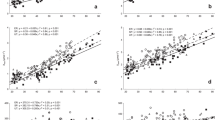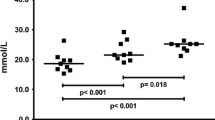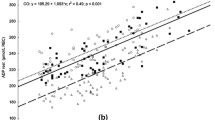Abstract
The purpose of the study was to characterize the changes in purine metabolism in long-distance runners in the main phases of their 1-year training cycle. Nine male athletes competing in distances 5 and 10 km at national/regional level, mean age 22.9 ± 0.6 years, practising sport for 8.6 ± 0.3 years, participated in the study. The changes in plasma concentrations of hypoxanthine (Hx), xanthine (X) and uric acid (UA) and the activity of the enzyme HGPRT in red blood cells haemolysate were followed in four characteristic points of the annual training cycle: preparatory phase (specific subphase), competition period, transition period and preparatory phase (intermediate subphase). Resting and postexercise plasma concentrations of X and, Hx and HGPRT activity changed significantly during 1-year training cycle. Significant changes in postexercise Hx values between training phases were found, from 9.3 μmol l−1 in competition period to 22.9 μmol l−1 in transition period (Friedmann’s ANOVA, P < 0.01). Postexercise UA values ranged from 371 to 399 μmol l−1 and did not change significantly between training phases. An increase in resting (from 52.0 to 58.4 IMP mg−1 Hb min−1, P < 0.05) and postexercise (from 70.7 to 76.2 IMP mg−1 Hb min−1, not significant) HGPRT activity between the specific preparation and competition period was observed. In the transition period, Hx postexercise concentration increased (22.9 μmol l−1, P < 0.01) and HGPRT postexercise activity decreased (58.8 IMP mg−1 Hb min−1, P < 0.01) significantly. The results indicate that the level of plasma Hx at rest and after standard exercise may be a useful tool for monitoring the adaptation of energetic processes in different training phases and support the overload/overtraining diagnosis.






Similar content being viewed by others
References
Baldwin J, Snow RJ, Febbraio MA (2000) Effect of training status and relative exercise intensity on physiological responses in men. Med Sci Sports Exerc 32(9):1648–1654. doi:10.1097/00005768-200009000-00020
Balsom PB, Seger JY, Sjödin B, Ekblom B (1992) Physiological response to maximal intensity intermittent exercise. Eur J Appl Physiol 65(2):144–149. doi:10.1007/BF00705072
Banaszak F (1999) The metabolism of purine and pyrimidine nucleotides in essential hypertension. The assessment of influence of antihypertensive drugs (in Polish). Monographic Book no. 341, University School of Physical Education, Poznań
Banaszak F, Rychlewski T (1989) Adenylate metabolism in physical exercise. Biol Sport 6(4):255–268
Banaszak F, Rychlewski T (1992) Selected problems of nitric metabolism of adenylic nucleotides: level of oxypurines and ammonia in conditions of physical effort. Stud Phys Cult Tour 2:115–122
Bangsbo J, Sjödin B, Hellsten-Westing Y (1992) Exchange of hypoxanthine in muscle during intense exercise in man. Acta Physiol Scand 146(4):549–550. doi:10.1111/j.1748-1716.1992.tb09465.x
Becker BF (1993) Towards the physiological function of uric acid. Free Radic Biol Med 14(6):615–631. doi:10.1016/0891-5849(93)90143-I
Bhattacharya AK, Panda PK, Das Gupta PK, De AK (1983) Pattern of venous lactate and pyruvate after submaximal exercise in athletes training in different disciplines. Int J Sports Med 4(4):252–254. doi:10.1055/s-2008-1026044
Bianchi GP, Grossi G, Bargossi AM, Fiorella PL, Marchesini G (1999) Can oxypurines plasma levels classify the type of physical exercise? J Sports Med Phys Fitness 39(2):123–127
Bompa T (1999) Periodization: theory and methodology of training. Human Kinetics, Champaign, pp 147–311
Boulieu R, Bory C, Baltasat P, Gonnet C (1983) Hypoxanthine and xanthine levels determined by high performance liquid chromatography in plasma, erythrocyte and urine samples from healthy subjects: the problem of hypoxanthine level evolution as a function of time. Anal Biochem 129(2):398–404. doi:10.1016/0003-2697(83)90568-7
De Bono DP (1994) Free radicals and antioxidants in vascular biology: the roles of reaction kinetics, environment and substrate turnover. QJM 87(8):445–453
Green HJ, Jones S, Ball-Burnett M, Farrance B, Ranney D (1995) Adaptations in muscle metabolism to prolonged exercise and training. J Appl Physiol 78(1):138–145
Gutmann J, Wahlenfeld AW (1974) l-/± lactate determination with lactate dehydrogenase and NAD. In: Bergmayer HU (ed) Methods of enzymatic analysis. Academic Press, New York, pp 1586–1587
Harkness RA, Simmonds RJ, Coade SB (1983) Purine transport and metabolism in man: the effect of exercise on concentrations of purine bases, nucleosides and nucleotides in plasma, urine, leucocytes and erythrocytes. Clin Sci 64(3):333–340
Hellsten Y, Tullson PC, Richter EA, Bangsbo J (1997) Oxidation of urate in human skeletal-muscle during exercise. Free Radic Biol Med 22(1–2):169–174. doi:10.1016/S0891-5849(96)00286-9
Hellsten Y, Svensson M, Sjödin B, Smith S, Christensen A, Richter EA, Bangsbo J (2001) Allantoin formation and urate and glutathione exchange in human muscle during submaximal exercise. Free Radic Biol Med 31(11):1313–1322. doi:10.1016/S0891-5849(01)00631-1
Hellsten-Westing Y, Ekblom B, Sjödin B (1989) The metabolic relation between hypoxanthine and uric acid in man following maximal short-distance running. Acta Physiol Scand 137(3):341–345. doi:10.1111/j.1748-1716.1989.tb08762.x
Hellsten-Westing Y, Balsom PD, Norman B, Sjödin B (1993a) The effect of high-intensity training on purine metabolism in man. Acta Physiol Scand 149(4):405–412. doi:10.1111/j.1748-1716.1993.tb09636.x
Hellsten-Westing Y, Norman B, Balsom PD, Sjödin B (1993b) Decreased resting level of adenine nucleotides in human skeletal muscle after high–intensity training. J Appl Physiol 74(5):2523–2528
Hellsten-Westing Y, Ekblom B, Kaijser L, Sjödin B (1994) Exchange of purines in human liver and skeletal muscle with short term exhaustive exercise. Am J Physiol 266:R81–R86
Jarasch ED, Bruder G, Heid HW (1986) Significance of xanthine oxidase in capillary endothelial cells. Acta Physiol Scand Suppl 548:39–46
Ketai LH, Simon RH, Kreit JW, Grum CM (1987) Plasma hypoxanthine and exercise. Am Rev Respir Dis 136(1):98–101
Moyer JD, Henderson JF (1983) Salvage of circulating hypoxanthine by tissues of the mouse. Can J Biochem Cell Biol 61(11):1153–1157
Murray AW (1971) The biological significance of purine salvage. Annu Rev Biochem 40:811–826. doi:10.1146/annurev.bi.40.070171.004115
Parks DA, Granger DN (1986) Xanthine oxidase: biochemistry, distribution and physiology. Acta Physiol Scand Suppl 548:87–99
Ralston MA, Merola JA, Leier CV (1991) Depressed aerobic enzyme activity of skeletal muscle in severe chronic heart failure. J Lab Clin Med 117(5):370–372
Rychlewski T Banaszak F, Szczęśniak Ł, Jastrzębski A (1994) Activity of hypoxanthine–guanine–phosphoribosyltransferase (HGPRT) in healthy individuals and in the cases of metabolic civilization-related diseases. In: International congress on applied research in sport “The Way to Win”, The Finnish Society for Research in Sport and Physical Education, Helsinki, p 33 (Abstract)
Rychlewski T, Banaszak F, Szczęśniak Ł, Konys L, Jastrzębski A (1997) Hypoxanthin im Blutplasma als Indikator der Intensität von körperlicher Anstrengung. Sportonomics 1:47–52
Sahlin K, Ekberg K, Cizinsky S (1991) Changes in plasma hypoxanthine and free radical markers during exercise in man. Acta Physiol Scand 142(2):275–281. doi:10.1111/j.1748-1716.1991.tb09157.x
Sahlin K, Tonkonogi M, Söderlund K (1999) Plasma hypoxanthine and ammonia in humans during prolonged exercise. Eur J Appl Physiol Occup Physiol 80(5):417–422. doi:10.1007/s004210050613
Sjödin B, Hellsten-Westing Y (1990) Changes in plasma concentration of hypoxanthine and uric acid in man with short-distance running at various intensities. Int J Sports Med 11(6):493–495. doi:10.1055/s-2007-1024844
Sjödin B, Jacobs I, Svedenhag J (1982) Changes in onset of blood lactate accumulation (OBLA) and muscle enzymes after training at OBLA. Eur J Appl Physiol Occup Physiol 49(1):45–57. doi:10.1007/BF00428962
Spencer M, Bishop D, Lawrence S (2004) Longitudinal assessment of the effects of field hockey training on repeated sprint ability. J Sci Med Sport 7(3):323–334. doi:10.1016/S1440-2440(04)80027-6
Stathis CG, Febbraio MA, Carey MF, Snow RJ (1994) Influence of sprint training on human skeletal muscle purine nucleotide metabolism. J Appl Physiol 76(4):1802–1809
Stathis CG, Zhao S, Carey MF, Snow RJ (1999) Purine loss after repeated sprint bouts in humans. J Appl Physiol 87(6):2037–2042
Stathis CG, Carey MF, Hayes A, Garnham AP, Snow RJ (2006) Sprint training reduces urinary purine loss following intense exercise in humans. Appl Physiol Nutr Metab 31(6):702–708. doi:10.1139/H06-074
Stolk JN, De Abreu RA, Boerbooms AMT, de Koning DGM, de Graaf R, Kerstens PJSM, van de Putte LBA (1995) Purine enzyme activities in peripheral blood mononuclear cells: comparison of a new non-radiochemical high-performance liquid chromatography procedure and a radiochemical thin-layer chromatography procedure. J Chromatogr B Anal Technol Biomed Life Sci 666:33–43. doi:10.1016/0378-4347(94)00571-L
Sutton JR, Toews CJ, Ward R (1980) Purine metabolism during strenuous exercise in man. Metabolism 29(3):254–260. doi:10.1016/0026-0495(80)90067-0
Tullson PC, Whitlock DM, Terjung RL (1990) Adenine nucleotide degradation in slow-twitch red muscle. Am J Physiol Cell Physiol 258:C258–C265
Wung WE, Howell SB (1980) Simultaneous liquid chromatography of 5-fluorouracil, uridine, hypoxanthine, xanthine, uric acid, allopurinol and oxipurinol in plasma. Clin Chem 26(12):1704–1708
Author information
Authors and Affiliations
Corresponding author
Rights and permissions
About this article
Cite this article
Zieliński, J., Rychlewski, T., Kusy, K. et al. The effect of endurance training on changes in purine metabolism: a longitudinal study of competitive long-distance runners. Eur J Appl Physiol 106, 867–876 (2009). https://doi.org/10.1007/s00421-009-1079-5
Accepted:
Published:
Issue Date:
DOI: https://doi.org/10.1007/s00421-009-1079-5




